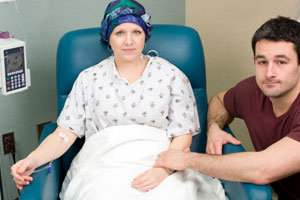SOME patients with cancer who may benefit from chemotherapy may be missing out on this treatment because of a shortage of medical oncologists, according to new research.
The research, published in the latest issue of the MJA, found that Australia’s chemotherapy utilisation rate, defined as the proportion of new cancer patients who received chemotherapy, was only 19% — well below the optimal rate of 51%. (1)
“This is of some concern because it implies that some patients who may benefit from chemotherapy are not receiving it”, the researchers wrote.
The research was based on a survey of 94 lead clinicians from Australian medical oncology practices, asking about their practice in 2008. The response rate was 81%.
The researchers said their study probably underestimated the chemotherapy utilisation rate because many of the respondents did not include data about the number of new patients receiving chemotherapy, but even correcting for this was unlikely to show the rate approximated expected standards.
Possible explanations for the low use of chemotherapy included suboptimal referral rates for patients with cancer, patients referred with advanced rather than early stage cancer and low prescribing rates of chemotherapy to new patients with cancer.
Less than half the people diagnosed with cancer were reported to have even seen a medical oncologist (MO) in 2008.
An article published in the same issue as the research, by Professor Bogda Koczwara, professor of medical oncology at Flinders University, and several other leading cancer specialists, said Australia’s low chemotherapy utilisation rate may reflect limited awareness about the value of medical oncological treatment among referring doctors or limited access to MOs. (2)
“With the existing medical oncology workforce, we simply do not have the capacity to increase the chemotherapy utilisation rate”, the specialists wrote.
The research estimated that Australia has a shortfall of 92 to 157 medical oncologists, based on an optimal workload of 150 new patients per year for each full-time equivalent (FTE) oncologist. By 2014, the shortfall was projected to reach 84–156 MOs.
Australia’s MOs were found to have a high clinical workload compared with national and international benchmarks. Each FTE MO saw an average of 270 new patients each year, well above Canadian recommendations of 160–175 patients and the Australian benchmark of 150.
Additional information from Royal Australasian College of Physicians revealed that the number of medical oncology trainees has increased in recent years, and is now greater than the number expected to retire in the specialty. However, this was not expected to substantially increase the capacity of the workforce, particularly because of the prevalence of part-time and overseas work.
“Addressing the shortage needs a multilevel approach aimed at increasing the supply of MOs by increasing recruitment, training and participation rates, improving clinical practice efficiency, and the introduction of innovative methods of service delivery through involvement of other health professionals and use of models of shared care”, the researchers wrote.
Professor Koczwara and colleagues said the most promising workforce solution was to redistribute the existing workforce and optimise work practices.
There was a risk that a recent federal government investment of $560 million in infrastructure for rural cancer centres may not reach its full potential given the workforce shortages, they said.
In the same issue of the MJA researchers reported that 5-year survival rates for lymphoma patients in South Australia had substantially increased between 1977 and 2007. (3)
Outcomes for patients with non-Hodgkin lymphoma improved significantly, with an 18.7 percentage point increase in 5-year survival rates, most likely due to the use of bone marrow transplantation and rituximab.
– Sophie McNamara
1. MJA 2012; 196: 58-61
2. MJA 2012; 196: 32-33
3. MJA 2012; 196: 54-57
Posted 16 January 2012

 more_vert
more_vert